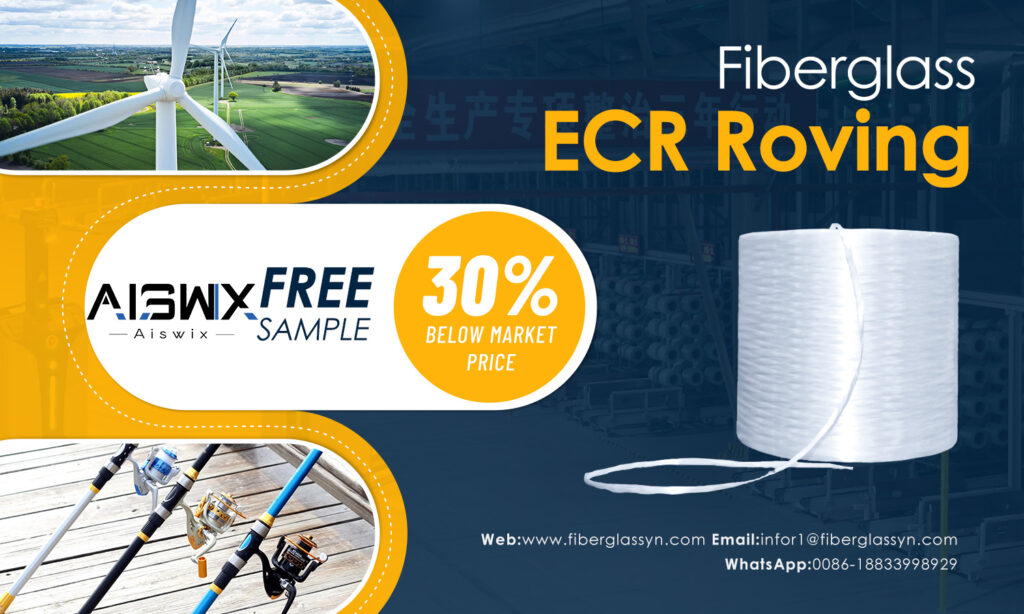
Introduce
Wind power, as a clean and renewable energy source, has been widely promoted and applied globally in recent years. One of the core components of wind power systems is the wind turbine, and the wind turbine blades are crucial parts that directly affect power generation efficiency and performance. The design and manufacturing of wind turbine blades are directly related to the efficiency and reliability of the entire wind power generation system. Therefore, how to create wind turbine blades that are tens to hundreds of meters long, yet lightweight and strong, has become a significant concern. This article discusses the key techniques and challenges in making lightweight yet strong wind turbine blades, with a particular focus on the application of fiberglass ecr roving.
The Importance of Lightweight and
Strong Wind Turbine Blades
Enhancing Wind Power Efficiency
Wind turbine blades play a pivotal role in converting wind energy into mechanical energy. By optimizing the design and material selection of the blades, wind energy can be captured and utilized to the greatest extent, improving the efficiency of wind turbines. Lightweight yet strong blades can maintain stable operation under various wind speed and direction conditions, ensuring that the wind turbine continues to work efficiently.
Reducing Costs and Improving Sustainability
Creating wind turbine blades that are lightweight yet strong can help reduce costs and increase sustainability. Lightweight blades require fewer resources and energy during manufacturing, transportation, and installation. Additionally, because light and strong blades can withstand greater wind loads, they can extend the service life of the blades, reducing maintenance and replacement costs. This will not only help lower the overall cost of wind power generation but also enhance the sustainability of wind power and promote its long-term stable position in the energy structure.
Positive Environmental Impact
The positive impact of lightweight yet strong wind turbine blades on the environment and renewable energy cannot be overlooked. As a clean and renewable energy form, wind power is significant for reducing carbon emissions, improving air quality, and protecting the ecological environment. Manufacturing lightweight and strong wind turbine blades can further enhance the environmental performance of wind power generation, reduce dependence on fossil fuels, and promote the development and application of renewable energy. Therefore, lightweight and strong wind turbine blades hold great strategic importance for promoting energy transformation and combating climate change.
Material Selection And Characterization:
Fiberglass ECR Roving
Fiberglass ecr roving is a type of fiberglass specifically designed for enhanced corrosion resistance. It has been widely adopted in various industries due to its superior properties. In the context of wind turbine blades, fiberglass ecr roving offers several advantages:
High Strength-to-Weight Ratio
This characteristic is crucial for wind turbine blades, as it allows for the creation of long blades that are still lightweight and easy to handle.
Corrosion Resistance
Wind turbine blades are exposed to harsh environmental conditions. The enhanced corrosion resistance of ecr roving ensures longer lifespan and lower maintenance costs.
Durability and Fatigue Resistance
Wind turbine blades experience continuous stress and strain. The durability and fatigue resistance of fiberglass ecr roving make it an ideal material for this application.
Ease of Processing
Fiberglass ecr roving can be easily molded into complex shapes, allowing for innovative blade designs that can enhance aerodynamic performance.
Structural Design Optimization
Structural design optimization is another critical aspect of manufacturing lightweight and strong wind turbine blades. By optimizing the structural design, the amount of material used can be minimized, reducing the blade’s weight and enhancing its lightness. Key considerations in structural design include:
- Stress Analysis: Understanding the stress distribution across the blade at different wind speeds and directions is essential. This information helps in determining the optimal cross-sectional shape and thickness distribution.
- Reinforcements: Incorporating stiffeners and strategically placing fibers within the blade structure can significantly improve strength and stiffness while minimizing weight.
- Aerodynamic Design: The aerodynamic performance of the blade can be enhanced by optimizing the shape and surface finish, reducing drag, and increasing lift.
To summarize, material selection and design optimization are crucial in manufacturing lightweight and strong wind turbine blades. Rational material selection and design can ensure that the blades have sufficient strength and stiffness while maintaining their lightness, thereby enhancing wind power generation efficiency and reliability.
Key Technologies and Challenges
in the Manufacturing Process
Manufacturing lightweight yet strong wind turbine blades involves several key technologies and challenges. The manufacturing process must overcome various difficulties to achieve the desired outcomes.
Due to the enormous size of wind turbine blades, large-scale manufacturing equipment is essential. Examples include:
- Large Molds and Forming Equipment: These are necessary for creating the shape of the blades.
- Automated Systems: Large-scale automated systems are required for processing and assembling the blades, improving production efficiency and ensuring accuracy and consistency.
Strict quality control measures are essential during manufacturing to ensure that the blades meet design specifications. Key aspects include:
- Material Quality Control: Ensuring that the materials used meet the required standards.
- Process Parameter Monitoring: Monitoring various parameters such as temperature and humidity during the manufacturing process to ensure stability and consistency.
The enormous size of wind turbine blades poses significant challenges in processing and transportation. Special transportation equipment and technologies are required to ensure safe transportation. On-site assembly and installation also need to be carefully planned and executed.
The manufacturing process of blades involves complex processes and technologies, requiring a high level of expertise. This includes in-depth research and exploration in material selection, structural design, and process control to ensure that the blades are lightweight yet strong.
The manufacturing process also faces challenges such as long production cycles and high costs. Comprehensive planning and management are necessary to ensure the high quality and efficiency of the blades.
Future Prospects and Innovation Trends
Development and Improvement of Technology
With continuous advancements in science and technology, manufacturing technology is also evolving. In the future, more advanced manufacturing equipment and processes will be introduced to improve production efficiency, reduce costs, and enhance blade quality and performance.
Green Materials and Sustainable Manufacturing
As awareness of environmental protection and sustainable development increases, there is a growing focus on the research and application of green materials and sustainable manufacturing technologies. In the future, more environmentally friendly materials, such as bio-based composites and recycled materials, will be introduced in the manufacturing of wind turbine blades. These materials have good environmental performance and reproducibility, effectively reducing the consumption of natural resources and environmental pollution, thus promoting the sustainable development of wind turbine blade manufacturing.
Innovative Blade Designs and Structures
- Advanced Materials and Processes: Using more advanced materials and processes to improve wind resistance and durability, further enhancing the efficiency and reliability of wind power generation.
- New Blade Shapes and Structures: Exploring innovative blade shapes and structures, such as twisted or folded blades, to adapt to different wind field conditions and improve transportation efficiency.
In summary, the future of wind turbine blade manufacturing will face numerous challenges and opportunities. Continuous innovation and exploration are required to meet the growing demand for wind power generation and promote the development and application of renewable energy.
In Conclusion
As a leading company focusing on glass fiber composite materials and manufacturing technology, Aiswix will continue to uphold the business philosophy of “innovation, quality, and sustainable development”, aiming to make significant contributions to the sustainable development of the wind power industry by integrating advanced materials such as fiberglass ecr into our solutions. Actively participate in international cooperation, strengthen collaboration and exchanges within and outside the industry, and jointly promote innovation and progress in wind power technology.



